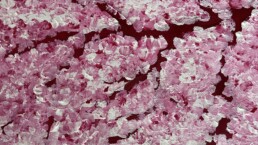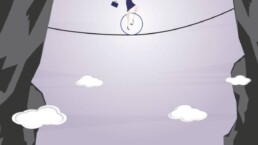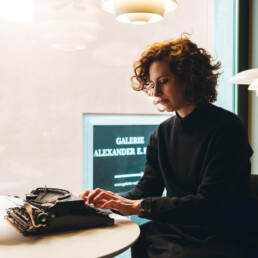
In this Letter of Inspiration, you will find thoughts on strategic development in times of crisis, on what lies behind the superficial meaning of beauty, and a radical view in which I describe art as a by-product of personal development. Enjoy!
A fundamental human competence
Many (business) models are based on that which is already known, and use the past as a point of reference in order to assess risk, to make analyses or budget plans for the next year. However, the limits of proven strategies become apparent as soon as unforeseen or first-time events (such as a pandemic) occur. What is needed then is not only the advice of experts, but, even more importantly, one's own intuition, as entrepreneurs reorient and translate an existing company into a new environment.
"Intuition is a fundamental human competence and therefore may well be a component of professional risk management.”
And intuition presents another advantage: Creating new thoughts, ideas and visions from within yourself makes you independent, as inner reflection is autonomous from external influences such as the analyses, habits and assessments of others. Of course it is pleasant to be protected or supported by others or outside factors, but the apparent security they offer is often fleeting and ephemeral. A good example of this is the current pandemic: unforeseeable, but fundamentally impacting all of our (business) lives. A conscious intuition is like a strong core, it gives stability yet freedom to move - hugely important in times of high-risk and change.
Artists, in their creative processes, rely on this inner voice: the intuition. Günther Uecker, a member of the ZERO art movement dedicated to a new beginning for art after the Second World War, described it as follows:
"There is something, and it is not yet expressed in my works, but I know that it is (...). Sometimes I have the feeling that I am close to it, but I do not know what it is (...)."As Dr. Nikolaus von Bomhard, former Chairman of the Board of Management of Munich Re, once said in a worthwhile FAZ article.
The creative process, whether in art or in business, is not easy. To dare to create something new requires courage, independent thought, and space. In this process, restrictions, predetermined paths and old knowledge act largely as weights chained to your ankle that prevent you from advancing. To free yourself from this ballast - to let go - is the real challenge, but also an opportunity.
A blank canvas
Why should a path that offers neither ease nor a guarantee of success be desirable? The security we find in something familiar is based on the concept of hope. Once the surface of this illusion is broken, it becomes clear that the strategy of hope is neither secure nor sustainable. Isn't the feeling of security rather a superficial cloak that lets one radiate self-confidence and even attraction (that is, beauty) to the outside world? However, even the most beautiful things eventually lose their sheen; specifically, when they touch the ground of reality.
A striking feature of the current pandemic situation is its ability to strip away masks and illusions. Superficial beauty vanishes, leaving us with two options: to try to keep up appearances for a while, or to allow them to dissolve and search instead for the truly “beautiful”. The latter approach begins with a search for characteristics that deviate from the shiny and immaculate surface. Often this leads back to the origin, where everything has started. The driver that made a company, an entrepreneur or concept successful.
What I mean by that? When you try to orient yourself in a city, you do not attempt to memorize seemingly identical asphalt streets. Instead, you identify striking reference points: an unusual house, a lone tree, a special store or a prominent sign. This is exactly what we ought to seek when we are fed up with superficial beauty. In order to break out from habitual patterns and to find your own clearly defined path to success, you have to look for what sets you apart. Rather than being an interchangeable asphalt street, you become an individual - “You start building your own statue". In art, one would say that the artist develops his own style; in the business world, I call this composure. Composure adds an important part to “the core”, which gives stability in high-risk times.
In this podcast interview, I develop further the idea of how to strengthen the gut feeling, as well as how this leads to finding composure and enhancing business development (in German).
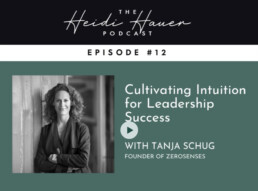
What inspired me recently: The Art Of Letting Go
I have recently been thinking about the end product of artistic creation: the artwork itself. I realized that often, what we admire as art is something that no longer has any meaning for the artist himself. The visible art piece is an expression of a moment of creation that emerged from a development process. Once you begin to flow with this rhythm, you do not stop to appreciate the beautiful end product, you continue to grow. Radically formulated, art can be considered a by-product of emotional and personal development. While we are still admiring and appreciating the “skin” he has shed, the artist is already one step ahead.
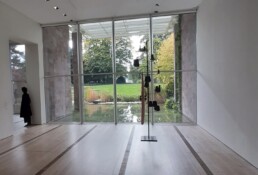
In the business world, it is often the other way round: letting go is difficult. Once you have “created” something, you want to preserve it. You know all too well how much energy has gone into the company, the product or the team you have developed or created.
Here you can look to the art world for inspiration: The white canvas - the emptiness that represents a new beginning - can also be seen as the space of potential. The moment to dare to try something new is the white canvas and the first step, like the first brush stroke, is the most difficult of all.Erik Brynjolfsson, a professor at Stanford University, once said in a lecture:
"Sometimes you have to kill your darlings"
Some situations require the art of letting go, and Brynjolfsson believes that it is only then that truly great things come into being. This is not meant to be an invitation to let go of everything that is dear to you, but encouragement to consider what you may be compulsively holding on to and what may be keeping you from making the first brushstroke on the next white canvas. Just ask yourself: What is the worst that can happen when you start a new brushstroke? Nothing really bad, you might think. Well, why not try then?
Thank you for joining me for this episode of the Letter of Inspiration! Feel free to share this letter with colleagues and friends.
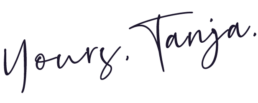
Share
